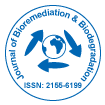Leveraging Bioinformatics in Bioremediation: Computational Strategies for Enhancing the Degradation of Environmental Pollutants
*Corresponding Author:Received Date: Jan 01, 2025 / Published Date: Jan 31, 2025
Copyright: © 0 . This is an open-access article distributed under the terms of the Creative Commons Attribution License, which permits unrestricted use, distribution, and reproduction in any medium, provided the original author and source are credited.
Abstract
Emerging environmental pollutants, including pharmaceuticals, personal care products, and industrial chemicals, B i o pose significant risks to ecosystems and human health due to their persistence and toxicity. Traditional remediation methods often fail to address these complex contaminants efficiently. Microbiome engineering, a novel approach that involves manipulating microbial communities to enhance pollutant degradation, offers promising solutions for bioremediation. This review explores the potential of microbiome engineering for the bioremediation of emerging pollutants, focusing on how tailored microbial consortia can be designed to degrade specific contaminants in diverse environmental settings. The paper discusses various strategies, such as gene editing, synthetic biology, and the optimization of microbial interactions, to enhance the metabolic pathways involved in pollutant degradation. Additionally, the challenges of applying microbiome engineering at a large scale, including environmental stability, regulatory concerns, and ecological impacts, are examined. The review also highlights recent advancements in microbiome research and provides future directions for improving the effectiveness of microbiome-based bioremediation for emerging environmental pollutants.

 Spanish
Spanish  Chinese
Chinese  Russian
Russian  German
German  French
French  Japanese
Japanese  Portuguese
Portuguese  Hindi
Hindi 
